
I wouldn’t be exaggerating if I said that the Sansui 9090 receiver is one of the best receivers ever made because it is. A fully restored Sansui 9090 is something to behold both visually and aurally. Produced in 1975 it was top of the line for Sansui and the bigger brother of the Sansui 8080. It produced 110 watts per channel. That was a lot of power for that time. In fact, when Radio Electronics reviewed it in 1976 it was the most powerful integrated receiver they had ever tested. It retailed for around $750 and was meant for those audio enthusiasts that either didn’t have the space for separate components (amplifier, tuner, preamplifier) or couldn’t afford them. The 9090 definitely lessened the performance gap that existed at the time between integrated receivers and separate components.

When the Sansui 9090 stereo is powered on via the power switch just under the tuning meters an adjacent red light will flash for a few seconds until voltages have been stabilized after which it will turn green and the audio signal will be sent to the speakers. This is to protect any connected speakers from voltage fluctuations. The power button is one difference between the 9090 and the 9090DB. The 9090DB has a rectangular, black plastic, and somewhat ugly, power button that doesn’t really match the other buttons. I prefer the 9090’s look.
Notice the triple tone controls (Bass, Mid, Treble). They are click stop design. Bass and Treble both have defeat switches as well as selectable turnover points. Not common at all in receivers of that time. What else does the 9090 have? Well, it has a speaker selector switch for three sets of speakers, dual headphones jacks, dual concentric master volume and balance controls, loudness and mono/stereo lever switches, a rotary tape selector, a mic level input jack and a 5-position program selector switch.
The dial scale is linearly calibrated and there are a pair of tuning meters (sensitivity/multipath and center-of-channel) to the left of it. Note also the very large flywheel-coupled tuning knob to the right of the dial scale that gives a nice smooth, weighted feel when tuning.
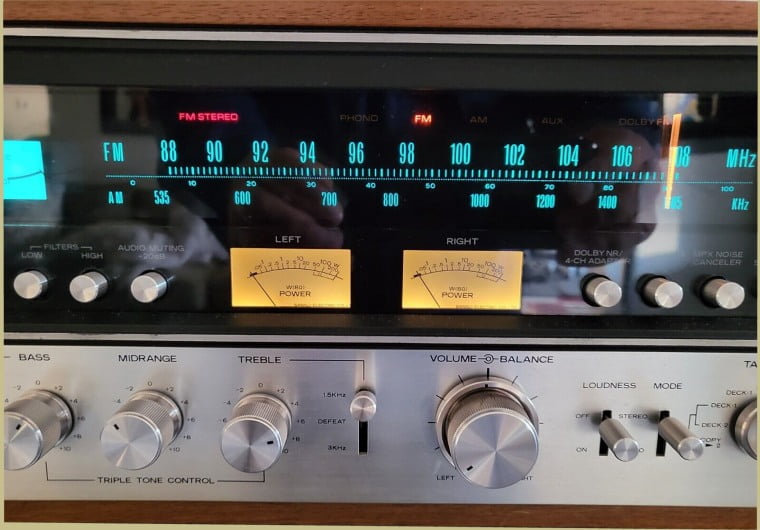
You know a receiver has some power when it has dual power meters integrated into the front panel. Not only that but the Sansui 9090’s meters are calibrated from 0.5 to 200 watts at 8 ohms. This was one of the first integrated receivers to employ dual power meters.
There are push buttons for low and high cut filters as well as a -20dB mute button which is useful if you have to answer the phone or door. It will reduce the volume by 20dB without you having to disturb your overall volume settings.
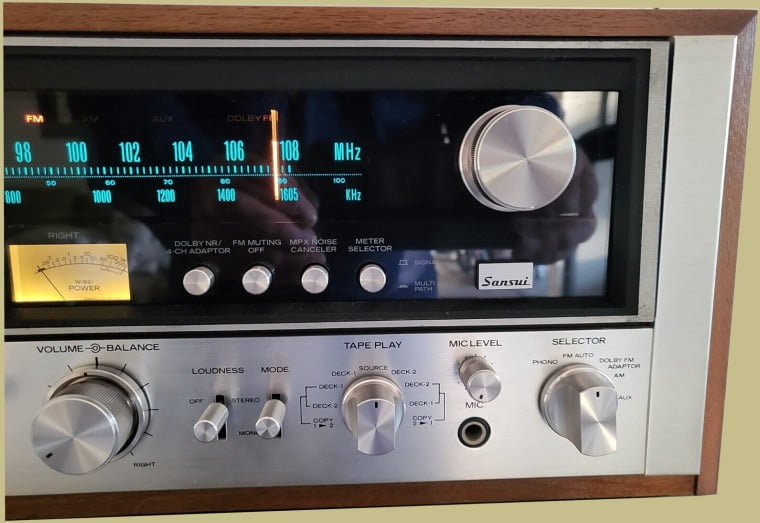
The Dolby push button is for an optional external Dolby noise reduction adaptor. It wasn’t until the Sansui 9090DB that Dolby circuitry was added internally.
Sansui’s first production run of the 9090 sold out quickly and Sansui had to scramble to keep up with demand.

The 9090 and 9090DB are the only models to have a real wood case. The lower end models had simulated wood pattern vinyl.
Specifications:
- Tuning range: FM, MW
- Power output: 110 watts per channel into 8 ohms (stereo)
- Frequency response: 10Hz to 30kHz
- Total harmonic distortion: 0.2%
- Damping factor: 10
- Input sensitivity: 2.5mV (MM), 100mV (DIN), 100mV (line)
- Signal to noise ratio: 70dB (MM), 80dB (line)
- Channel separation: 50dB (MM), 50dB (line)
- Output: 100mV (line), 30mV (DIN), 0.75V (Pre out)
- Dimensions: 21 5/16″ W x 7 3/16″ H x 15 11/16″ D (540 x 182 x 397mm)
- Weight: 51.4 lbs (23.3kg)
- Year: 1975
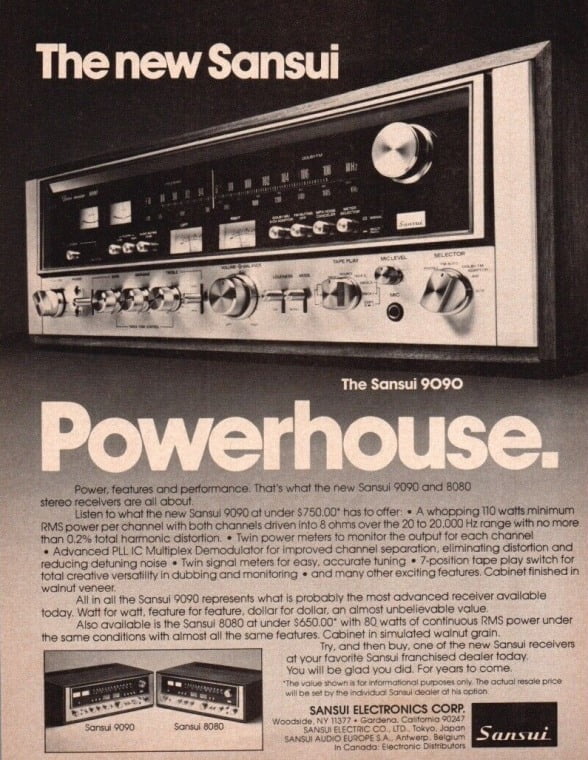
The inside chassis of the 9090 is very nicely laid out with a 4-section tuning capacitor and dual-gate MOS-FET used as an RF amplifier. There are three discrete IF stages with ceramic filters and three limiter stages. There is also a phase-lock-loop IC stereo multiplex decoder that, when activated, senses noise in the audio signal (radio) and filters it out. It is automatically disengaged when the stereo signal is strong.
The power amp is direct coupled and powered from a dual-polarity supply. When reviewed by a prominent audio magazine of the time the Sansui 9090 produced 143 wpc at 0.2% total harmonic distortion (THD) and mid frequency levels. Even at 20 Hz and 20kHz extremes it output 132 and 138 wpc respectively. THD at the rated output of 110 wpc was rated at 0.2% but measured at 0.065%. Wow!
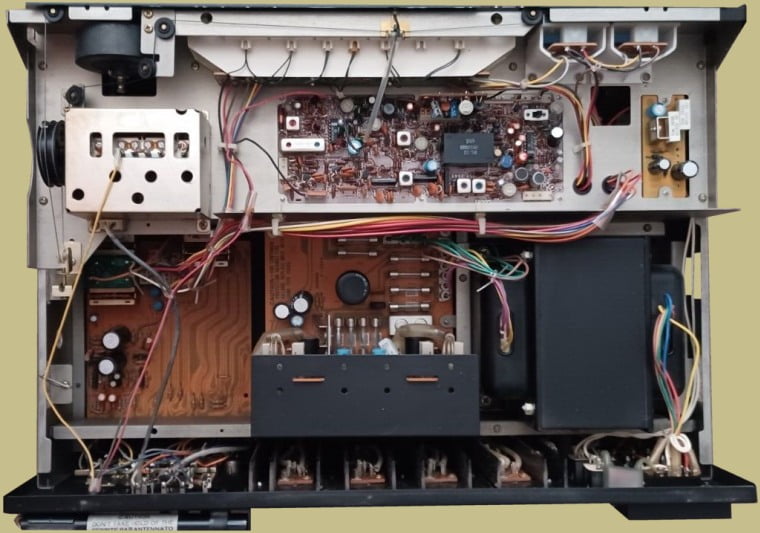
There are some issues to be aware of if you’re considering purchasing a Sansui 9090 (or 9090DB for that matter). The solder joints for the tuning dial lights as well as the meter lights tend to fail over the years and need to be re-flowed. That means that swapping out old bulbs for new bulbs won’t always solve the problem. The selector switches can get really dirty and cause all sorts of problems as well. Cleaning them should be a top priority if anything isn’t working properly (even the dial lights).
The dial lights also can be problematic due to a bad wafer pad in the selector switch and some owners modify them so that they will stay on all the time. If the fuse is blown, the bulbs are burned out, or the lamp holder solder joints are bad, the mod won’t make difference though. Here is a thread on the mod over at AudioKarma. Also, this modification is for the 8080 and 9090 only. It doesn’t apply to the 9090DB or 8080DB.
Sansui issued a bulletin modification in 1976 to address an issue with the F-2547 driver board. In short, a serious failure can occur which can damage both the receiver and your speakers if the issue is not remedied. Fortunately this can only occur under certain somewhat rare circumstances. One is when you run both the A and B speakers simultaneously. Most 9090’s have probably had this fixed (definitely the units manufactured after April, 1976). You can tell if the mod has been done if the driver board has fuses in plastic sleeves. If it does then it has been done. You can find a thread on the issue HERE. The original bulletin is HERE.
If your inclined to work on your Sansui 9090 yourself there are multiple kits available on eBay:
The back panel has three large heat sinks at the center with triple sets of speaker terminals to their right to isolate them from the low level inputs on the left. The 110 watts per channel can easily power most any speakers including those with low efficiency. It also has two AC outlets – one switched and one not.
The inputs on the back allow for connection of two tape decks, an AUX, and a phono. That’s right – just one turntable can be connected to the 9090. The 9090DB allowed two turntables to be connected.

Should you buy the 9090DB or the 9090? Well, it seems as though the 9090DB is more common, hence, more readily available. But, the Dolby circuitry is known to cause some issues in the 9090DB and repairing them is not easy (or cheap). I also like the appearance of the front panel on the 9090 better than the 9090DB. The 9090DB does have a bit more power and two phono inputs but for my money I would buy the 9090.
At the time it was made the Sansui 9090 receiver had an excellent price to performance ratio. Today the 9090 is many multiples of its 1975 price of $750 but still retains its price to performance ratio. It is definitely a holy grail receiver for collectors and audio enthusiasts.
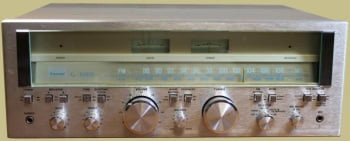

Trying to reach you to get info on restoration of a Sansui QRX 7500. Please provided contact and how best to reach someone. Thanks.